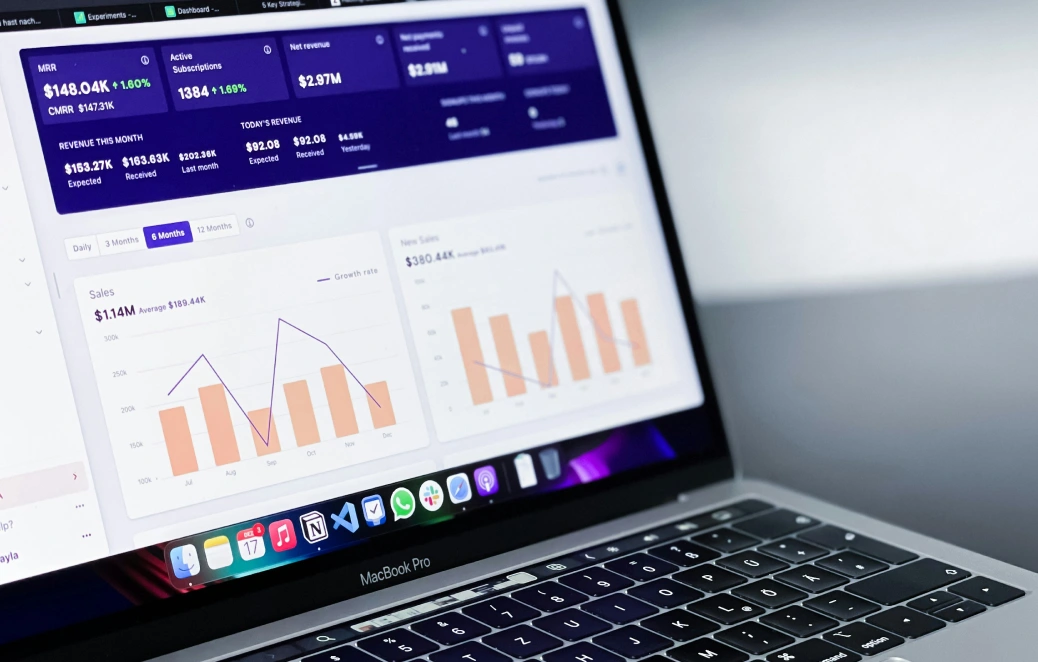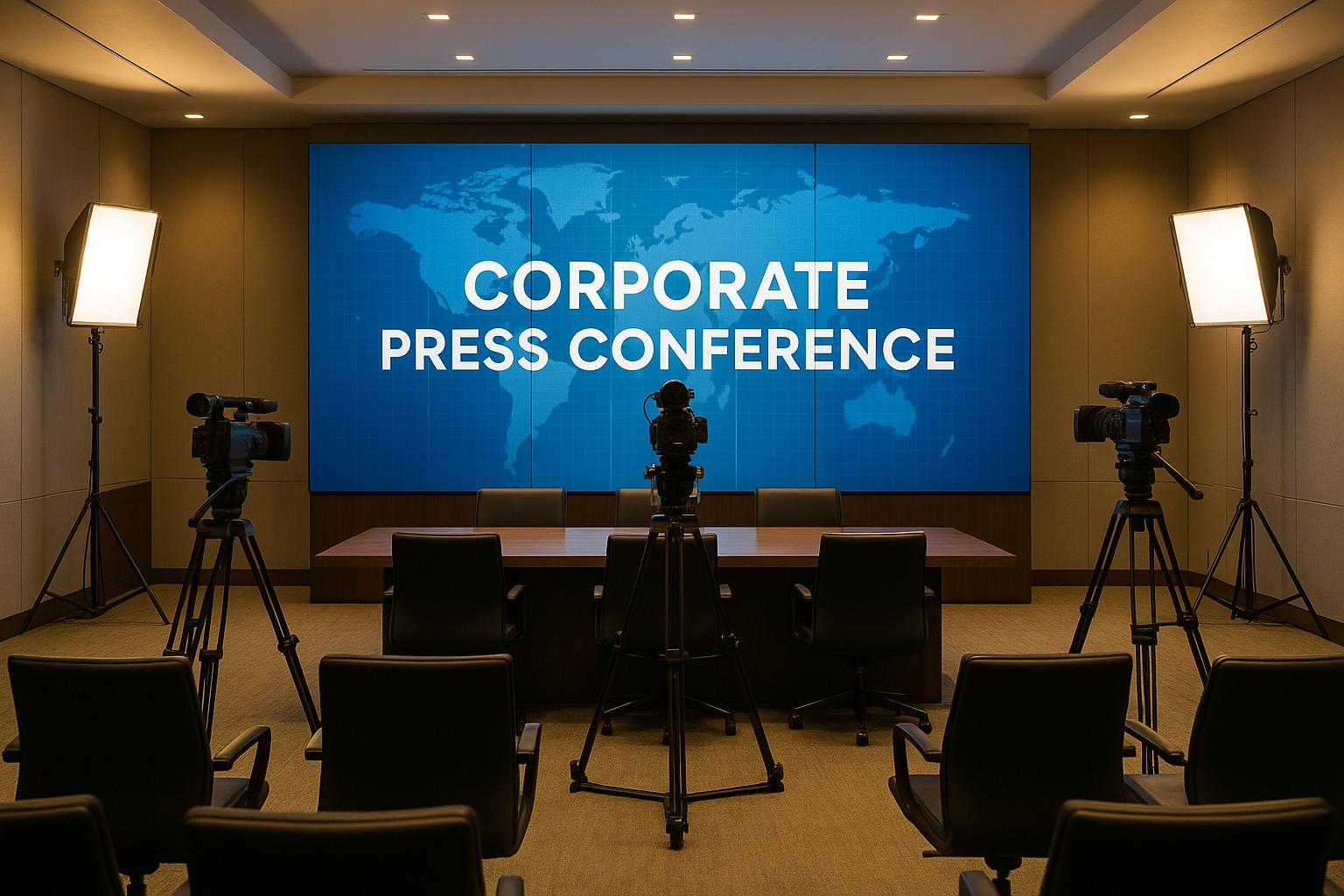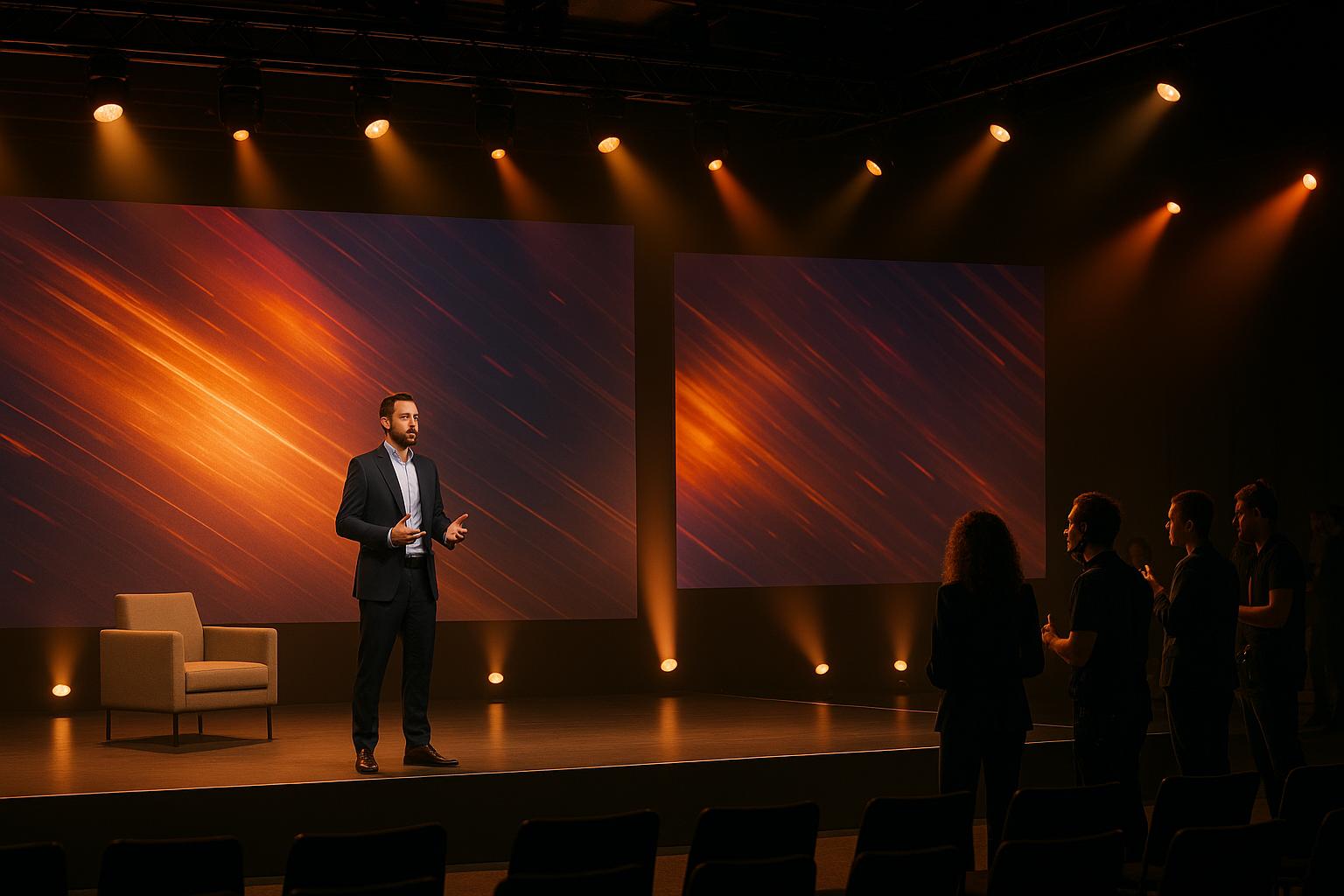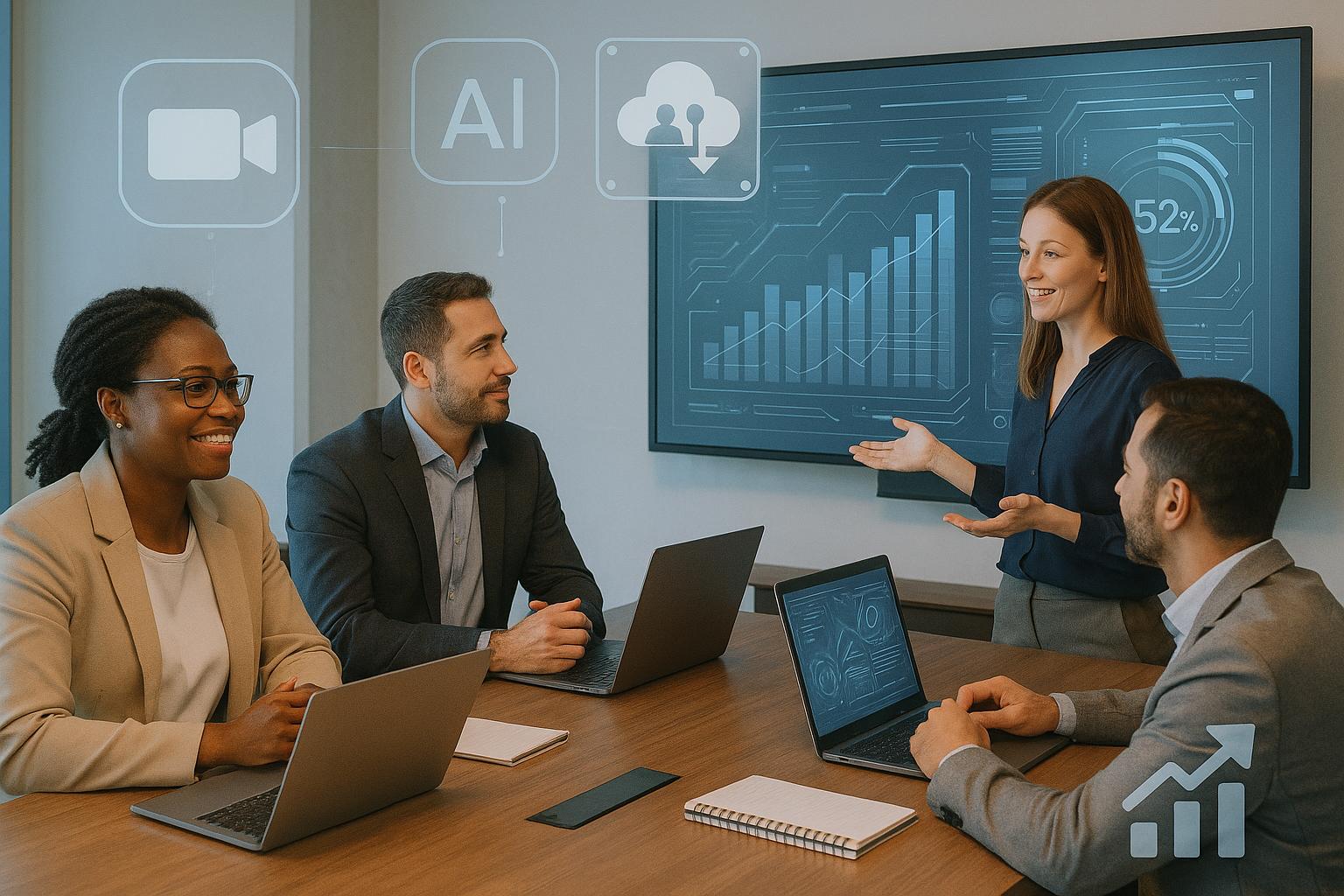Guide To Planning A High-Impact Corporate Sales Conference

Chief Executive Officer
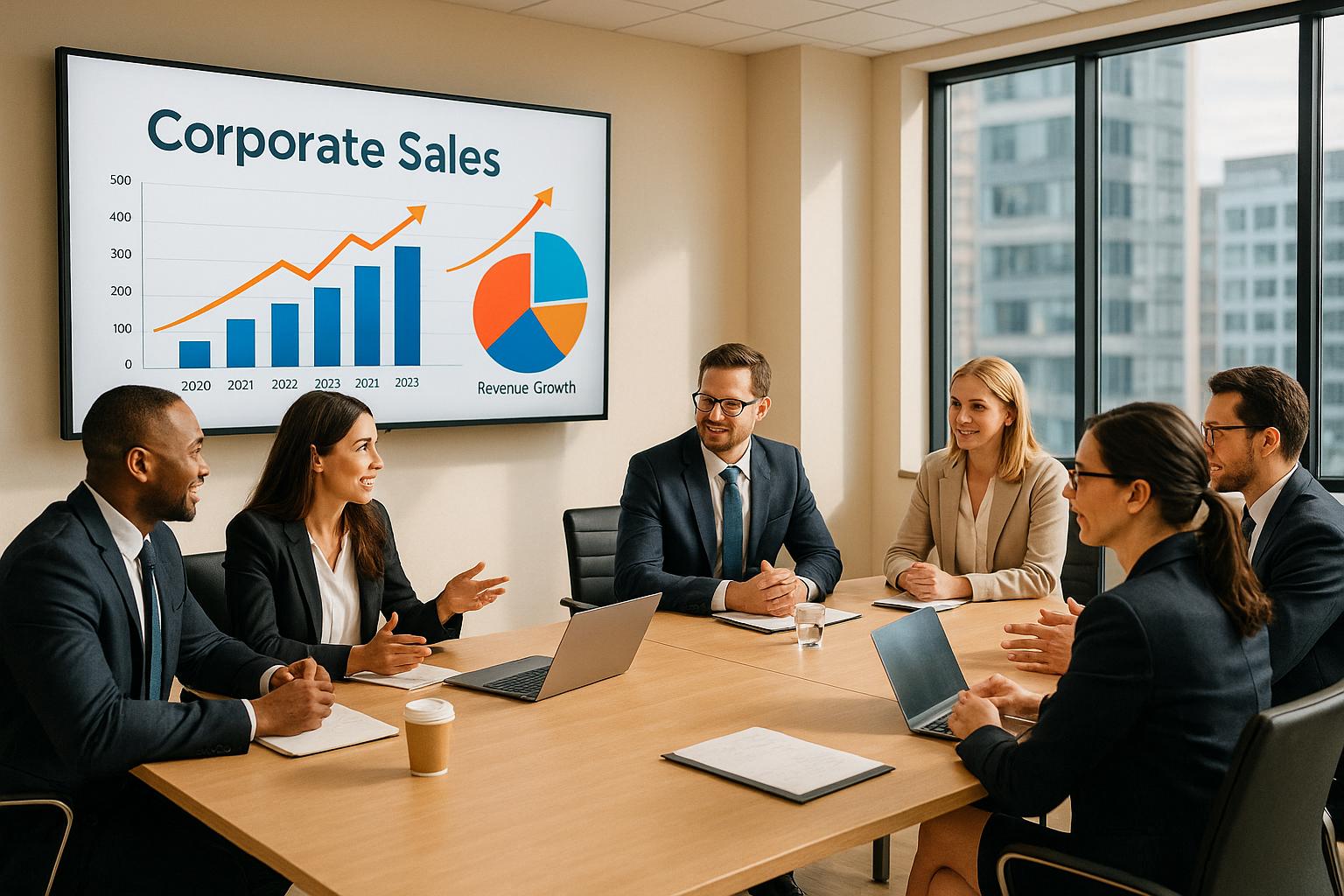
Planning a sales conference can either drive real business results or waste resources if not executed properly. The key is aligning every detail with clear objectives and ensuring the event delivers measurable outcomes. Here's what you need to know to plan a successful corporate sales conference:
- Set Clear Goals: Define specific business outcomes (e.g., increasing sales by 25%, improving CRM adoption, or deepening customer relationships). Translate these goals into measurable KPIs like session attendance, sales growth, or networking impact.
- Engage Attendees: Balance educational and interactive sessions. Use diverse formats like workshops, keynotes, and peer-to-peer learning to cater to different learning styles.
- Leverage Technology: Invest in tools like live streaming, polling systems, and hybrid setups for seamless in-person and virtual participation.
- Prepare Early: Start planning months in advance to secure top venues, speakers, and vendors. Assign clear roles within your team for content, logistics, and budget management.
- Evaluate Success: Post-event, gather feedback, analyze data, and measure ROI to improve future events.
Supercharge Your Next Conference: 11 Game-Changing Tips
Setting Objectives and Success Metrics
Once you've established a strategic focus, the next step is to set clear, measurable goals to guide your planning. Without specific objectives, even the most well-executed events can miss the mark when it comes to delivering meaningful results for your business.
Defining Business Goals
Start by pinpointing the primary outcomes your conference should achieve. These goals should align with your organization's broader strategy and tackle specific challenges faced by your sales team.
Here are three key areas to address:
- Revenue Goals: These might include increasing quarterly sales by a set percentage, introducing new product lines with defined adoption targets, or expanding into untapped markets. For example, if your goal is to grow enterprise sales by 25% next quarter, you could dedicate significant time during the conference to enterprise-focused training sessions and case studies.
- Team Development: Focus on enhancing your team's skills, such as improving their grasp of sales methodologies, deepening product expertise, or fostering better collaboration between sales and marketing. If your team struggles with closing complex deals, you might want to include sessions on advanced negotiation tactics or consultative selling.
- Customer Relationships: Strengthen client partnerships, boost retention rates, or improve the customer experience through better sales practices. This could mean hosting workshops on account management strategies or integrating customer success into your sales process.
Be as specific as possible when setting these goals. Vague objectives like "improve sales performance" won’t cut it. Instead, aim for targets like "increase average deal size by 15% within six months" or "achieve 90% CRM adoption within 60 days." Once your goals are clear, turn them into measurable KPIs to track progress and success.
Measuring Success with KPIs
To measure the success of your conference, translate your goals into quantifiable KPIs that cover engagement, learning, business impact, and networking. Here's a quick breakdown:
| Metric Category | Example KPIs | Timeline |
|---|---|---|
| Engagement | Session attendance, app interactions, Q&A participation | During the event |
| Learning | Knowledge assessments, certifications earned | Immediately post-event |
| Business Impact | Sales growth, pipeline expansion, deal velocity | 30-90 days post-event |
| Networking | New connections, follow-up meetings, collaborations | 60 days post-event |
- Engagement Metrics: These provide real-time insights into how attendees interact with the event. Track session attendance, audience participation, and feedback through mobile event apps to see which sessions resonate most.
- Learning and Retention: Gauge whether attendees are absorbing the content by using pre- and post-event assessments. Follow-up surveys at 30 and 90 days can reveal how much knowledge participants retained and applied.
- Business Impact: Connect your conference to measurable business outcomes. Monitor sales performance, pipeline growth, deal velocity, and customer satisfaction scores after the event to evaluate its impact.
- Networking Metrics: Measure the collaborative benefits of your event by tracking new connections, mentorships, and cross-departmental relationships formed.
By focusing on these KPIs, you can align your event planning with tangible outcomes.
Aligning Objectives with Planning Decisions
Every planning decision should tie back to your objectives. Here's how to ensure alignment:
- Content Strategy: Choose speakers, topics, and session formats that directly support your goals. For instance, if your aim is to boost enterprise sales, prioritize speakers with extensive experience in enterprise strategies and case studies. Avoid popular speakers whose expertise doesn't align with your objectives.
- Technology and Formats: The format of your sessions should reflect your goals. Interactive workshops are great for skill-building, while panel discussions work well for fostering relationships. If learning outcomes are a priority, invest in platforms that track engagement and assess knowledge retention.
- Budget Allocation: Your spending should reflect your goals. For example, if strengthening customer relationships is a priority, you might allocate more funds to networking events. If you're launching a new product, invest in technology for demonstrations.
- Venue and Logistics: The choice of venue should complement your objectives. A creative space might inspire innovation, while a formal setting with advanced technology might suit a conference focused on operational excellence.
The best sales conferences create a feedback loop between objectives and execution. Regular check-ins during the planning process can help ensure every decision moves you closer to your goals. If something doesn’t contribute to your objectives, consider reallocating those resources to something that does.
When objectives are clear and measurable, gaining stakeholder support becomes much easier. Executives are more likely to approve budgets when they understand exactly what outcomes the conference will deliver and how success will be evaluated.
Creating an Effective Conference Agenda
A great conference agenda does more than just outline sessions - it sets the tone, energizes attendees, and delivers insights they can act on. The trick is to create a schedule that balances impactful content with opportunities for networking and meaningful interaction.
Structuring the Conference Flow
The best sales conferences follow a rhythm that keeps energy levels high while allowing time for learning and connection. Start with a strong keynote that addresses key challenges and hints at solutions. From there, align session intensity with attendees' natural energy cycles.
Energy management is key. Plan content-heavy sessions during times when participants are most alert. For example, schedule skill-building workshops mid-morning or early afternoon. Build in 15-minute breaks every 90 minutes to give attendees time to process information and network. Longer breaks - about 30 minutes - can encourage deeper conversations and informal learning.
Think about the flow of content throughout the day. Mornings can start with inspiring sessions to energize participants. Midday sessions should focus on skill development when attention is at its peak. Wrap up the day with actionable takeaways that attendees can implement right away. This progression - from motivation to education to application - keeps the experience engaging and productive.
End the event with a closing session that ties everything together. Summarize the key messages and provide clear next steps so attendees leave with a plan for what to do differently when they return to work. A strong finish ensures the momentum carries beyond the conference.
Once you’ve established the overall structure, diversify the session formats to cater to different learning preferences.
Using Different Session Formats
To keep everyone engaged, vary the session types based on the content and audience. Mixing formats ensures that attendees stay interested and that the material resonates with a range of learning styles.
- Keynotes: Ideal for big-picture topics, company updates, and industry insights. Keep these sessions between 30-45 minutes to maintain attention and allow for questions.
- Panel discussions: Perfect for exploring complex issues or trends from multiple perspectives. Panels work best with 3-4 participants and a moderator. Make sure to leave at least 15 minutes for audience Q&A.
- Interactive workshops: These are the gold standard for hands-on learning. Use them for skill-building activities like negotiation techniques or CRM training. Limit the group size to 25–30 participants so everyone can actively engage.
- Breakout sessions: Offer specialized tracks for different roles or interests, such as inside sales, field sales, or product-specific training. Let attendees choose sessions that align with their needs.
- Peer-to-peer learning: Tap into the expertise within your team. Case studies from top performers or collaborative problem-solving sessions can provide practical, immediately applicable insights.
- Technology demonstrations: Make these hands-on whenever possible. Let attendees explore tools and features themselves - this approach boosts adoption and reduces the learning curve.
Selecting and Preparing Speakers
Speakers play a critical role in the success of your conference. Whether they’re internal or external, their expertise and delivery can make or break a session.
Internal speakers should be chosen for their knowledge and communication skills, not just their job titles. A high-performing sales rep who can clearly explain their process often provides more value than an executive focused on strategy.
When bringing in external speakers, focus on relevance. A specialist who understands your industry and challenges will resonate more than a general motivational speaker. Always vet external speakers by checking references and reviewing their past work.
Preparation is just as important as selection. Provide speakers with a concise brief that outlines your goals, audience, and any key company information.
- Conduct rehearsals to catch any technical issues and ensure their content aligns with your message. Practice Q&A sessions for critical presentations.
- Share guidelines on presentation length, slide design, and interaction expectations. Specify whether the tone should be instructional, inspirational, or tactical.
- Offer templates or examples of past successful presentations to guide them.
For virtual speakers, test their tech setup ahead of time and have support on standby during their session. Always have a backup plan in case a speaker can’t present.
Equip speakers with a resource kit that includes company background, attendee profiles, and logistical details. This helps them tailor their presentations to the audience and the event’s objectives.
Ultimately, every speaker should feel like a partner in achieving the conference’s goals. When they understand your vision and feel invested in its success, their presentations will resonate more deeply with your audience and drive meaningful results.
Using Audiovisual Technology and Production
A well-executed AV setup can take your conference from ordinary to extraordinary. Modern AV technology does more than just support your content - it boosts engagement, ensures everyone can participate, and creates a polished, professional atmosphere that aligns with your company’s image. In fact, having strong AV capabilities is just as important as having clear objectives and a well-organized agenda.
Using Advanced AV Solutions
Gone are the days when a microphone and projector were enough for a successful sales conference. Today’s events demand live streaming capabilities, which allow remote team members to join and expand the event’s reach. High-quality, multi-angle cameras enhance the virtual experience by capturing speakers and audience interactions in detail.
To keep attendees engaged, consider using interactive tools like digital polling systems and Q&A platforms. These allow participants to vote on topics and submit questions in real-time, which is especially impactful during panels and keynotes. Speakers can respond directly to audience interests, creating a more dynamic and engaging session.
For events with both in-person and remote attendees, hybrid technology is a must. Two-way audio and video connections ensure virtual participants can actively join discussions, while large screens displaying remote attendees foster a sense of inclusion. Breakout room technology can also replicate the networking opportunities of in-person events, making it easier for smaller groups to connect.
Lighting and screen setups can further enhance the experience. Intelligent lighting systems can adjust automatically based on the session type - bright and energizing for morning keynotes, or softer for more intimate presentations. Multi-screen setups allow speakers to display slides alongside live data, social media feeds, or participant polls, keeping the visuals engaging and diverse.
Sound quality is another critical factor. Wireless microphones with automatic frequency coordination eliminate interference, while ceiling-mounted speaker arrays ensure even sound distribution. For larger venues, hearing loop systems can improve accessibility for attendees with hearing difficulties.
Planning for Technical Support and Backup Plans
Technical issues can throw a wrench into even the best-planned conference. That’s why having on-site technical support is non-negotiable. A good rule of thumb is one technician for every 100 attendees, with additional specialists for live streaming or hybrid setups.
Backup systems are equally important. Keep spare projectors, extra microphones, and secondary internet connections on hand to avoid disruptions. Ask speakers to provide their presentations in multiple formats - cloud storage, USB drives, and email attachments - to ensure accessibility no matter what.
Reliable internet connectivity is essential, especially for live streaming and engagement tools. A dedicated fiber connection, separate from the venue’s standard WiFi, ensures smooth performance. Aim for at least 10 Mbps upload speed per stream, plus extra bandwidth for attendee devices.
To keep everything running smoothly, create a technical rundown that outlines every AV cue, transition, and equipment change. Include backup procedures and vendor contact information, and share this document with your production team. Full technical rehearsals 24 hours before the event can help identify and resolve potential issues.
Comparing AV Solutions
Choosing between in-house AV management and professional production partners depends on your event’s size, complexity, and budget. Here’s a quick comparison:
| Factor | In-House AV | Professional Partners (e.g., Corporate Optics) |
|---|---|---|
| Cost | Lower rental fees | Higher upfront investment |
| Expertise | Limited to internal knowledge | Specialized event production experience |
| Equipment | Standard rental-grade gear | Broadcast-quality equipment |
| Support | Business hours only | 24/7 on-site technical support |
| Scalability | Challenging for large events | Easily handles 50 to 5,000+ attendees |
| Risk | Full responsibility on your team | Professional liability and backup systems |
| Setup | 2-3 days for complex setups | Same-day setup for most configurations |
In-house AV management is suitable for smaller events with straightforward needs. It gives your team control over the setup and allows for real-time adjustments. However, it requires significant time and effort from your staff and carries a higher risk of technical issues.
On the other hand, professional production partners like Corporate Optics bring expertise and high-end equipment that may be too expensive to rent independently. Their experience with corporate events allows them to anticipate challenges and provide solutions, making them ideal for hybrid events or conferences with live streaming. While the upfront cost is higher, the reduced risk and professional execution often make it worthwhile.
Ultimately, the choice depends on your event’s requirements and your team’s capacity. Smaller, simpler conferences may benefit from in-house management, but for complex events with multiple formats, investing in professional services can make all the difference. By carefully considering your AV needs, you’ll set the stage for a smooth and impactful event.
sbb-itb-ae35a94
Budgeting, Logistics, and Vendor Management
Financial planning is the backbone of any successful conference. Even the most engaging agenda or cutting-edge technology can fall flat without a well-thought-out budget and reliable logistics. To ensure your sales conference runs smoothly, you need a realistic budget that accounts for all expenses and dependable vendors who can bring your vision to life.
Creating a Detailed Budget
Start by setting a total budget and breaking it down into specific categories. Key areas to allocate funds include the venue, catering, audiovisual production, and speaker fees. Don’t forget to include a contingency fund for unexpected expenses.
Venue costs can vary significantly based on location, quality, and the length of the event. In larger cities, expect higher rates and additional charges for items like parking, extended setup hours, or enhanced connectivity. Catering is another area that requires careful planning - negotiate per-person rates that include service fees and taxes to avoid surprises.
Speaker fees will depend on their expertise and demand, but you’ll also need to account for their travel and lodging. For audiovisual needs, costs hinge on the complexity of your setup. Determine whether a basic configuration meets your goals or if features like live streaming and interactive tools are necessary. Partnering with professional production teams can often simplify the process and save money in the long run.
Keep an eye on your spending by regularly updating your budget with categorized expenses. This helps you spot potential overruns early and adjust accordingly.
Choosing the Right Venue
The venue is the cornerstone of your conference experience. Start by ensuring the space can comfortably accommodate your attendees, with room for any last-minute additions.
Make sure the venue’s technical infrastructure supports your audiovisual needs, including reliable internet, staging, lighting, and projection capabilities. Accessibility is also crucial - verify that the facility offers accessible entrances, restrooms, and seating arrangements for all attendees.
Location matters too. A venue near major transportation hubs with ample parking or shuttle services can make a big difference in attendee convenience. Additionally, check for any extra fees related to access times or setup requirements to avoid surprises.
Once you’ve secured a venue that meets your needs, it’s time to focus on coordinating with vendors to bring your event to life.
Managing Vendor Coordination
Smooth vendor coordination can turn a complicated event into a polished experience. Assign a single point of contact for each vendor to streamline communication and avoid misunderstandings.
When selecting vendors, prioritize those with proven experience in handling corporate events similar to yours. Always request references to confirm their reliability and expertise.
Be thorough in contract negotiations. Clearly outline expectations, including setup and breakdown times, equipment specifications, and performance standards. This ensures everyone is on the same page from the start.
Create a detailed timeline that shows when each vendor needs to complete their tasks and how their work fits into the overall event schedule. Regular updates and consistent communication will help keep everything on track.
Corporate Optics specializes in managing vendor communications and on-site logistics, allowing your team to focus on engaging attendees and achieving your strategic goals. With the right planning and coordination, your conference can deliver a seamless and impactful experience.
Post-Event Analysis and Improvement
Taking the time to analyze your event after it ends is more than just a good practice - it's how you turn a one-time success into a repeatable formula for future wins. While it’s tempting to celebrate and move on, the most impactful conferences are the ones that evolve based on lessons learned.
Collecting Attendee Feedback
Getting feedback from attendees is a cornerstone of post-event analysis. Start collecting it right away while the experience is still fresh. Sending out surveys within 24 hours helps capture attendees’ peak engagement and ensures their responses are detailed and accurate.
Design your surveys to include both numerical ratings and open-ended questions. For example, ask about the quality of speakers, satisfaction with the venue, and which sessions provided the most takeaways. Dig deeper by asking what networking opportunities stood out or felt most beneficial.
Beyond surveys, monitor social media mentions and hashtags tied to your event. These unfiltered reactions can provide valuable insights into what resonated and what didn’t. Pair this with session attendance data to identify which topics drew the biggest crowds and which ones saw attendees dropping off early. Sometimes, behavior speaks louder than words.
Your sales team’s input is equally important. As the primary audience for the event, they can offer feedback on how the content connects to their daily work. Their insights should carry significant weight since they’ll be the ones applying the strategies and techniques shared during the conference.
Additionally, consider conducting short exit interviews as attendees leave. These casual conversations can uncover candid feedback, especially about logistical challenges or interpersonal dynamics that might not appear in formal surveys.
Analyzing ROI and Event Data
To measure the success of your event, calculate your return on investment (ROI) using metrics tied to the goals you set during the planning stage. For example, if lead generation was your focus, evaluate the number and quality of new prospects. If the goal was skill-building, look at post-event assessment scores or changes in performance metrics.
Break down your costs and compare them to the outcomes. This will help you see which expenses paid off and where adjustments might be needed next time. Don’t just focus on the obvious wins - document hidden costs and unexpected challenges too.
Dive into engagement data to see which sessions had the highest attendance or sparked the most participation. Look for patterns in when attendees seemed most engaged and when their attention waned. This can guide decisions for future agendas, helping you design content that keeps people interested.
It’s also worth tracking what attendees do after the event. Are they scheduling follow-up meetings, forming new partnerships, or implementing strategies they learned? These longer-term outcomes often reveal the true value of your event, even if they take weeks or months to unfold.
Companies like Corporate Optics can help turn your raw event data into meaningful insights. Their analytics tools can give you a clear picture of what worked and what didn’t, making it easier to plan your next event with confidence.
Conducting a Stakeholder Review
Within two weeks of the event, gather your key stakeholders for a review. Timing is important - details will still be fresh, and it’s easier to get everyone’s input before schedules fill up. Include leadership, sales, and event planning teams, and frame the discussion around the goals and metrics you set before the event.
Present a balanced view of the results, highlighting both successes and areas that need improvement. Being transparent builds trust and ensures future events get the resources they need. Focus the conversation on solutions. For every challenge raised, brainstorm actionable fixes and assign someone to take ownership of the follow-through.
Use this meeting to kick off planning for your next conference. Talk about timing, budget, and any big strategic shifts that might influence the event’s focus or format. Early alignment on these details saves you from scrambling later.
Finally, document everything. Notes on vendor performance, venue logistics, and lessons learned are invaluable for future planning. This institutional knowledge ensures consistency, even if team members change roles or responsibilities.
Wrap up the review with clear next steps and assigned responsibilities. Whether it’s immediate follow-up tasks or long-term planning, having a roadmap ensures your analysis leads to meaningful improvements.
Conclusion: Key Points for a Successful Sales Conference
Pulling off a successful sales conference comes down to setting clear goals, meticulous planning, and fine-tuning based on experience. These events don’t just happen - they’re the result of intentional efforts to align objectives, resources, and technology for maximum impact. Let’s break down the essentials.
Start by defining specific, measurable goals. Whether you’re aiming to generate leads, enhance skills, or strengthen team connections, these objectives should guide every aspect of your planning - from picking the venue to choosing the speakers.
Craft an agenda that keeps attendees engaged. Mix up session formats, bring in expert speakers, and structure the day to maintain energy and focus. A well-paced event, with a balance of activities, keeps participants invested and prevents burnout.
Don’t overlook the technical side. High-quality audiovisual equipment and dependable tech support ensure your message comes across clearly and professionally. When your production values are polished, it signals to attendees that their time is valued.
Equally important is measuring the success of your event. Post-conference evaluations - using both data and attendee feedback - are essential for improving future events. In fact, timely analysis can significantly boost your return on investment, helping you refine and enhance your strategy.
Corporate Optics can help you bring all these elements together seamlessly. From audiovisual design to post-event analytics, their comprehensive planning services take the stress out of execution. With their expertise in technical production and audience engagement tools, you can focus on delivering impactful content while they manage the logistics.
FAQs
How can I make sure the goals of my sales conference align with my company's overall business strategy?
To ensure your sales conference aligns with your company's overarching business strategy, begin by pinpointing your organization's primary objectives. From there, break these down into clear, measurable goals tailored to what you aim to accomplish during the event. For instance, if your company’s goal is to increase revenue by 15% this quarter, the conference could center on enhancing lead conversion tactics or refining upselling techniques.
Teamwork plays a big role here too. Collaborate with departments like marketing and product development to create an agenda that supports shared goals. Set clear KPIs to track progress, and regularly review these metrics to stay aligned and make adjustments as your strategy evolves.
How can I effectively engage both in-person and virtual attendees at a hybrid sales conference?
To make a hybrid sales conference engaging for both in-person and virtual attendees, it's all about creating moments where everyone feels involved and connected. Start by organizing hybrid discussion panels that include speakers participating both on-site and online. Add networking sessions designed to cater to both groups, ensuring no one feels left out.
Introduce interactive features like live polls, Q&A opportunities, and gamified activities to maintain energy and interest. Tools like chat boxes, virtual breakout rooms, and even digital swag bags can help remote participants feel more integrated into the experience. For a fun twist, try using social media contests or live challenges to unite both audiences in a shared activity.
Ultimately, the goal is to make sure every attendee - whether they're in the room or tuning in from afar - feels equally engaged and appreciated throughout the event.
What are the best ways to measure the ROI of a sales conference, and which metrics should I prioritize?
To evaluate the return on investment (ROI) of a sales conference, it’s essential to focus on metrics that capture both financial returns and broader strategic benefits. Start by looking at the direct revenue generated from the event - this could include sales or deals closed during or shortly after the conference. Compare this income to the total costs, such as venue fees, technology, staffing, and other associated expenses, to calculate a straightforward ROI percentage.
Beyond revenue, pay attention to other key indicators like the number of qualified leads collected, attendance rates, and the conversion rate of those leads into paying customers. Don’t overlook less tangible benefits, either. Metrics like improved team cohesion or heightened brand visibility can contribute to long-term growth. By keeping track of these data points, you’ll get a well-rounded view of how effective your event was and its overall impact.
Related Blog Posts
